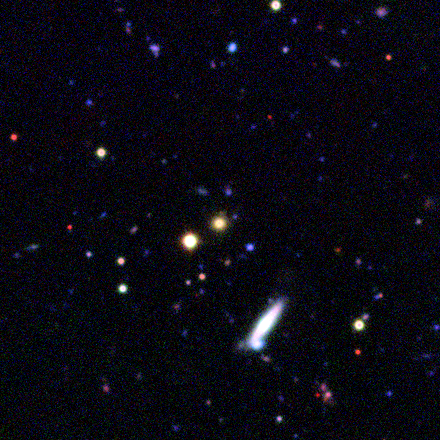#EdgeOn Galaxies marked as #lens
-
 by
JasonJason
by
JasonJason
Examples from
A search for edge-on galaxy lenses in the CFHT Legacy Survey ⋆
J.F. Sygnet1,2
, H. Tu3,1,2
, B. Fort1,2
, and R. Gavazzi1,2http://arxiv.org/pdf/1001.4336.pdf

Kind of looks like row 1 and row 3 from examples


Posted
-
 by
Tom_Collett
scientist
by
Tom_Collett
scientist
It might be, but I think it is two blue stars near each other. We want to see some curvature in the blue stuff and/or a counter image.
Posted
-
 by
JasonJason
by
JasonJason
marked as #edgeonlens which is similar to survey example row 1 image 1 and row 3 image 3

Posted
-
 by
drphilmarshall
scientist, admin
by
drphilmarshall
scientist, admin
Great hashtag this, edge-on lenses are very useful for understanding late-type or spiral galaxies. You should check out the papers by the SWELLS collaboration (including yours truly!). The edge-on aspect is important for a number of reasons: firstly it makes the arcs easier to see! But it also enables a complementary mass measurement to be made, using spectrographs on big telescopes to observe the speeds of the stars in the lens galaxy as they rotate (gradually) around the galaxy.
The problem with disk galaxy lenses is that they are not as massive as the bigger, brighter elliptical galaxies - so the Einstein radii are smaller. If multiple imaging is going on, the arcs form quite close to the central bulge of the lens galaxy, and will typically be buried there. Tom's right that a good indication of strong gravitational lensing is the curving of the image: if you don't see that, it's quite likely that feature is only being weakly lensed (magnified and displaced a bit, but not by som much that we can make good use of it). Most of Sygnet et al's candidates are only weak lenses. SL2SJ021523 and SL2SJ021711 look pretty good to me though.
I'd collect your candidate as a "possible" - I see the faint arc heading in the right direction, and its not too far out, but the main blue blob is a little circular. Having said that, its important to collect such things so that you can go looking for counter images once we get access to the individual filter images: in the bluest channel, there might be a faint counter image near the centre... Perhaps!
Great spot! 😃
Posted